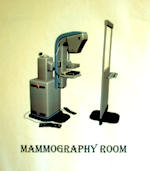
Modern Mammograms expose the breast to much less radiation compared to those in the past.
Types of Mammograms
1) Screening Mammograms
These Mammograms look for signs of cancer in the breast when it is too small to be felt by a woman or her doctor.
2) Diagnostic Mammograms
Diagnostic Mammograms investigate possible problems. For example, a woman found to have a lump in her breast or nipple discharge or an abnormal area detected in the Screening Mammogram, will need a Diagnostic Mammogram. Additional pictures are taken and enlarged to evaluate areas of suspicion easier.
Procedure
During a Mammogram, the breast is briefly compressed between two plates of the X-Ray machine.
The top plate is adjustable and the bottom plate, which holds the X-Ray film or a digital detector that produces the image, is fixed into place.
The X-Ray technologist compresses the breast to make the tissue layer thinner and to keep it from moving. This reduces the time of exposure to X-Rays and also makes the images sharper.
Usually, the patient experiences some pressure and no pain. The technologist can adjust the position of the patient if necessary. The duration of the entire procedure is about 20 minutes.

 is an X-Ray exam of the breast that is used to detect and evaluate changes in the breast.
is an X-Ray exam of the breast that is used to detect and evaluate changes in the breast.![]() (868) 660 7873 or
(868) 660 7873 or![]() (868) 639 8516
(868) 639 8516

